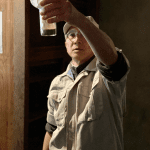 The epitome of it all expressed at Kikuyoi
The epitome of it all expressed at Kikuyoi
As the climax of the Sake Professional Course Level II course, we visit a couple of breweries. This year, as is the case most years, we head down to Shizuoka Prefecture a couple hours south, wherein sits majestic Mt. Fuji and about 30 great sake breweries. One of them makes a sake called Kikuyoi.
The toji is also the owner-inherit, Densaburo Aoshima, and their sake is quite popular. It sells out yearly, and they cannot make any more for a number of reasons. They are simply maxed out in terms of capacity, both infrastructurally and in human resources.
Much could be written about Aoshima-san, and in fact I have written about him in my ebook Sake’s Hidden Stories, which you can buy here. One of the most amazing things about him is how he is so into the concept of brewing sake by keiken to kan, or “experience and intuition.” He lives it, and breathes it. He oozes it. He walks it and he talks it. He brews his sake based on his five senses and what they tell him. He does not use email or a cell phone so as not to dullen those five senses. Yet in spite of that borderline fanaticism, he is warm, light-hearted and friendly.
We time our arrival every year so as to see the hugely important step of washing and soaking the rice. As simple as it sounds, the more thoroughly the rice is washed to remove the powder that clings to it from milling, the better the sake can be brewed. And the moisture content after washing and the subsequent soaking determine so much, including how the koji mold will grow, and how fast or slowly the rice will dissolve in the fermenting mash. And not only is precision of moisture content important, so is uniformity: ideally every single grain of the countless number going into a batch should have the same moisture content. Achieving that is easier said than done!
The way this uniformity is usually achieved is to split all the rice to be steamed into (most commonly) 10 kilogram baskets or bags. So if they are steaming 300 kilos, that would be 30 bags or baskets. It could run anywhere from five to fifty, for a reasonably sized batch of hand-crafted sake.
Typically, after soaking they will want the rice to have absorbed 28 to 33 percent more water. So if we use 32 percent for this discussion, 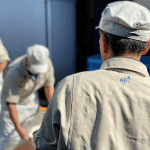 a basket weighing 10 kilos will weigh 13.2 kilos after washing and soaking, and absorbing exactly 32 percent, or another 3.2 kilos of water, in the process. But the rate of absorption is affected by many things: the milling rate, the variety of rice, the year’s harvest, and the weather – just for starters. So, not surprisingly, the speed at which it absorbs water will be different every time. What’s a brewer to do!?
a basket weighing 10 kilos will weigh 13.2 kilos after washing and soaking, and absorbing exactly 32 percent, or another 3.2 kilos of water, in the process. But the rate of absorption is affected by many things: the milling rate, the variety of rice, the year’s harvest, and the weather – just for starters. So, not surprisingly, the speed at which it absorbs water will be different every time. What’s a brewer to do!?
What they do is to test a few baskets. Based on experience and intuition, they soak the first basket for an amount of time they think is right, then weigh it. If it is too heavy, i.e. if too much water was absorbed, they back the time off a bit. If it was too light, i.e. if too little water was absorbed, they let it soak a bit longer. They do this for three or four baskets and then determine the time for that day, and that set of baskets of that rice. Then they soak the remaining baskets for that period of time.
By doing it this way, they can achieve a very uniform moisture content down to about one half of one percent. Read that again and let it sink in again. One half of one percent accuracy, uniformly across hundreds of kilos of rice.
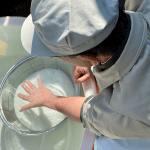 But Aoshima-san is different. He don’t need no stinkin’ clocks or stopwatches; he has his keiken to kan, his experience and his intuition. So what he does is to squat next to the wide but shallow tub in which the very thoroughly washed rice has just been placed, and take a handful of grains into the palm of his hand, keeping hand and rice grains submerged in that cold-ass water. And he watches ‘em. And watches ‘em. And he assesses how much water has been absorbed by seeing how the color around the outside of the grains changes. (Photos of Aoshima-san courtesy of Laura Kading.)
But Aoshima-san is different. He don’t need no stinkin’ clocks or stopwatches; he has his keiken to kan, his experience and his intuition. So what he does is to squat next to the wide but shallow tub in which the very thoroughly washed rice has just been placed, and take a handful of grains into the palm of his hand, keeping hand and rice grains submerged in that cold-ass water. And he watches ‘em. And watches ‘em. And he assesses how much water has been absorbed by seeing how the color around the outside of the grains changes. (Photos of Aoshima-san courtesy of Laura Kading.)
Of course, as he does that, someone else measures the time. And when he says, “Now!” they stop the timer. And he does in fact listen to the numerical results, and adjust the time up or down to increase or decrease water absorption. But he assesses it using his five senses, his experience, and his intuition.
The 20 of us gathered around the washing and soaking setup in a cramped outdoor courtyard behind their brewery, trying to find the balance between being close enough to see but not so close as to be in the way. As he scooped the first few grains from the first basket up into his hands, he still had the leeway to talk to us. He explained the color change, the speed of absorption and what affected that and when, and his objective for that day.
“I’m looking for 32 percent, exactly. It’s rice for koji, so I take it just a bit higher. And it’s Yamada Nishiki at 60 percent, so it absorbs fast, but not nearly as fast as if it were milled to 50% or more,” he explained.
“Today, taking all factors into consideration, I expect it will take nine minutes, plus or minus fifteen to thirty seconds, to achieve that 32 percent,” he summed up.
He continued on about how the rice was cracked this year, and that more cracks appear as you soak it. The problem is, he lamented, that 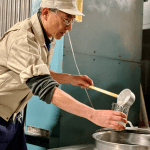 the cracked rice absorbs water faster than uncracked rice. So having cracked rice in the lot means that it is much harder to obtain uniformity of moisture, since some grains will absorb more water due to their cracks then their uncracked counterparts. And that means that the mold will not grow the same way on all rice, and that different grains will dissolve at different rates. That in turn makes everything less predictable.
the cracked rice absorbs water faster than uncracked rice. So having cracked rice in the lot means that it is much harder to obtain uniformity of moisture, since some grains will absorb more water due to their cracks then their uncracked counterparts. And that means that the mold will not grow the same way on all rice, and that different grains will dissolve at different rates. That in turn makes everything less predictable.
He further explained that while 10 kilogram baskets or bags are the norm, that isn’t precise enough for Mr. Maniacal; as such, he does everything in five kilogram baskets to add even more precision – and hassle of course – to his attention to detail.
As time wore on, he became silent, focusing on the changing surface color of the rice sequestered in his palm. Then he snapped back from his focused reverie, and calmly said, “now!” The timekeeper shouted out, “nine minutes exactly.”
Next, he pulled the basket out, let the excess water drip off a few minutes, and someone hauled it off and weighed it. And the call came from the guy standing in front of the scale: “Thirty two!”
Aoshima-san looked back over his shoulder at me, smiling – yea, verily smirking – with confidence and satisfaction. “Dja hear that? Thirty two exactly. Nailed it!,” he exclaimed. “ Keiken to kan!” Experience and intuition.
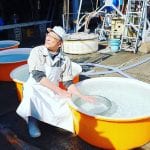 Next, to be doubly certain, he soaked the next basked fifteen seconds longer; it ended up at 33 percent. To wrap it up, he soaked the third basket fifteen seconds shorter; not surprisingly it ended up at 31 percent. He then instructed the other workers to soak the remaining few dozen baskets for nine minutes, exactly, and stepped aside to lead us on a tour of the rest of the kura.
Next, to be doubly certain, he soaked the next basked fifteen seconds longer; it ended up at 33 percent. To wrap it up, he soaked the third basket fifteen seconds shorter; not surprisingly it ended up at 31 percent. He then instructed the other workers to soak the remaining few dozen baskets for nine minutes, exactly, and stepped aside to lead us on a tour of the rest of the kura.
In truth, Aoshima-san is just one of many brewers that takes attention to detail as far as he can, and other brewers might express that in other ways that are just as amazing. This uncompromising attitude and practice is endemic to the sake world.
Later, as we ran through a tasting of his sake, he went back to the discussion that started as he palmed the rice in the tub of cold water in the outdoor winter weather. “Actually, it is not that difficult. But you have to do it every single day; that is the only way to get the experience, and the intuition that follows. You gotta live it, that’s all.”
Yeah; that’s all.




